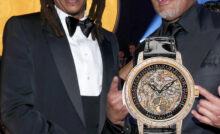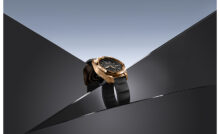A. Lange & Söhne honors its founder
A. Lange & Söhne launches an exceptional complication to honor its founder Walter Lange.
The German watchmaker, A. Lange &Söhne is known for crafting timepieces that embody the pinnacle of international fine watchmaking. A. Lange &Söhne recently announced a special edition watch to honour its founder Walter Lange, who passed away in January 2017. The brand is reintroducing 1815 model family with addition of extraordinary complications.
Named “Homage to Walter Lange” the special complication has a stoppable jumping second’s hand that dates back to a 150-year-old invention conceived by Ferdinand Adolph Lange.
In general, mechanical timepieces can be recognised by their “creeping seconds” hand. Depending on the balance frequency, the hand advances from second to second in five to ten steps. In short-time measurements, however, where seconds count in the literal sense, constant progression sometimes makes it difficult to pinpoint the beginning and the end of an event. Conversely, there is a horological complication that allows the exact measurement of the smallest unit of time: the “jumping seconds”.
The 1815 “Homage to Walter Lange” masters both chronometric disciplines. The small seconds hand in the subsidiary dial at 6 o’clock maps the frequency of 21,600 semi-oscillations per hour by performing six small steps as it advances from marker to marker. However, the blued sweep seconds hand performs precise jumps from second to second. It can be allowed to run continuously or immobilised if needed. A pusher at 2 o’clock starts and stops it. This is useful for heart rate measurements, for instance.
The jumping sweep seconds hand with the start/stop function was especially significant for Walter Lange. This is because it dates back to an 1867 invention of his great-grandfather, Ferdinand Adolph Lange. It was first implemented in a masterpiece crafted by his grandfather, Emil Lange. One of Germany’s first patents was granted to A. Lange &Söhne in 1877 for the enhanced design of a mechanism mounted on the three-quarter plate, and was referred to as a “one-second movement with a jumping hand”.
In the 1815 “Homage to Walter Lange”, the seconds jump is controlled according to the flirt-and-star principle, as was originally the case in the historic mechanism. After each full second, one of the six tips of the star liberates the tensioned lever arm, which watchmakers refer to as the “flirt”. It then swiftly rotates by 360 degrees before it is stopped by the next tip. This motion sequence causes the seconds hand to advance by one marker. The ratchet wheel located above the three-quarter plate has a dual function: It stores the power needed for the seconds jump, and at the same time causes the sweep seconds hand to stop.


More from our site
Recent Posts
Shaping Tomorrow’s Golf Champions With Leela Palace Bengaluru
The 3rd edition of The Leela Golf Tournament celebrated young talent and brought together skill, precision and camaraderie!
The 3rd edition of The Leela Golf Tournament celebrated young talent and brought together skill,…
The Duo Behind KAIA Goa & Gigi Bombay, Redefines Hospitality
In conversation with the founders of Pawan Shahri and Nikita Harisinghani, the duo behind Chrome Hospitality Asia
In conversation with the founders of Pawan Shahri and Nikita Harisinghani, the duo behind Chrome…
Precision, Durability, and Swiss Legacy
Victorinox launches the Swiss Army collection, featuring three distinct models that emphasise exceptional quality, resistance and versatility
Victorinox launches the Swiss Army collection, featuring three distinct models that emphasise exceptional quality, resistance…
A New Era of Luxury Interiors With Sussanne & Gauri Khan
Sussanne Khan & Gauri Khan unite to bring an awe-inspiring, six-storey sanctuary of luxury, art, and design in Hyderabad
Sussanne Khan & Gauri Khan unite to bring an awe-inspiring, six-storey sanctuary of luxury, art,…
Air India x Lufthansa: Fly To These International Destinations Now
Expanding their codeshare partnership, Air India and Lufthansa Group have added 100 new routes to their combined network
Expanding their codeshare partnership, Air India and Lufthansa Group have added 100 new routes to…
Luxury’s Most Recent & Vibrant Launches This Season
The luxury landscape is brimming with bold innovations, striking partnerships, and immersive experiences
The luxury landscape is brimming with bold innovations, striking partnerships, and immersive experiences


